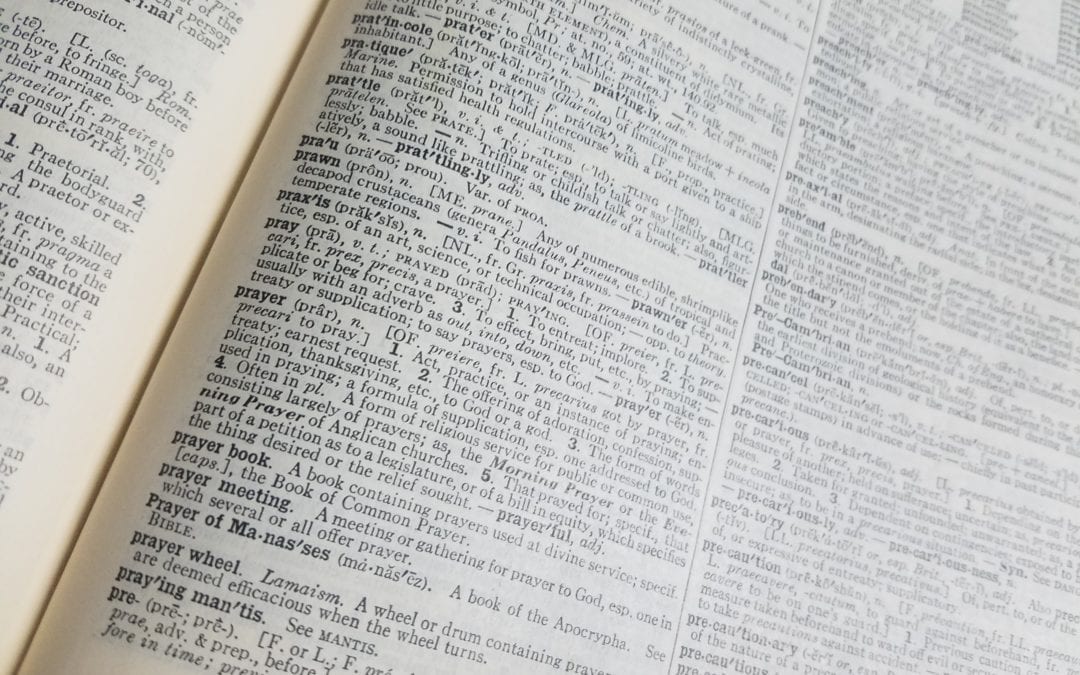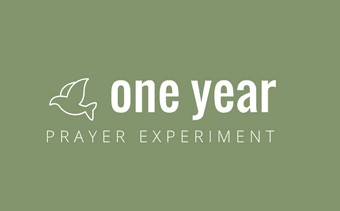What is prayer?
It sounds like such a simple question. The answer is often simply assumed. But I think it is vital to clearly define what prayer is.
First of all, I am committing to doing it for 30 minutes everyday for the next year. I need to make sure that what I spend my time doing really is prayer. Good accountability depends on good definitions. It is no different with prayer. So before I pray for 182.5 hours and report back to you about it, let’s clearly define what prayer is.
Answering this question is also made difficult by the fact that there is no one passage in the Bible that clearly defines prayer. We see the Word command us to pray, teach us how to pray and tell us about people praying. Yet, there is nowhere in the text do we find a clear answer to the question of “what is prayer?”
We will use as a starting place the definition of prayer most people carry with them.
“Prayer is just talking to God”
The most common definition of prayer, and likely the first one in our heads, is that prayer is simply talking to God. What I like about this definition is that it is so simple. The practice of prayer really is summed up in that phrase – when we pray we talk to God.
This common definition however is a little bit reductionist. It is a little one-directional. “I” talk “to God.” Someone else we only talk to comes to mind: Santa Clause. Who has ever stopped to listen to Santa Clause? Has anyone  ever asked Santa what he wanted for Christmas? Do we know of anyone who has been encouraged by the man in red? Or confronted by him for those acts that warrant the naughty list? Such one-sided communication does not result in a relationship of any depth or meaning.
ever asked Santa what he wanted for Christmas? Do we know of anyone who has been encouraged by the man in red? Or confronted by him for those acts that warrant the naughty list? Such one-sided communication does not result in a relationship of any depth or meaning.
Aside from shallowness, the unfortunate reality seems to be that simply defining prayer as talking to God leads to two other problems. First, practicing this definition of prayer can lead to one just rattling off our list of desires. I do know what else to talk about, so I will just ask you for things. That’s a prayer life that is hard to get excited about. And one that is hard to sustain. Especially if God is not granting all – or any – of your requests.
Second, putting this definition of prayer into practice can just lead to babbling. We all have that friend who can talk for an hour and never talk about something substantive. The same thing can happen with God. Unsure what to say, but motivated, we just start talking. God, let me tell you about my day . . . There is a time and place for processing your day with the Lord. But words with out substance are just words. Just like an hour with our babbling friend does not result in much of a relational connection, many words do not connect us to our Savior.
“Prayer is a conversation with God”
Bill Bright was the founder of Campus Crusade for Christ, an international parachurch ministry now known as Cru. In many of his discipleship writings he expanded the definition of prayer. Bill Bright said prayer is having a conversation with God. This is a wonderful expansion of the definition of prayer. It strongly emphasizes the relational aspect of prayer. Prayer now becomes a two-way exchange. We communicate to God. God communicates to us. We have questions. He can answer. We seek guidance. He can lead.

This definition makes it okay for us to have a tough day and tell him, “Lord, I have had a tough day. Let me tell you about it . . .” But after we have vented to him – because it is a conversation and not a monologue – God can respond. He may speak words of hope and encouragement into our hearts. He might remind us of the help he offers through the Holy Spirit. The Lord might even speak conviction into your life.
As foreign as this may seem, a beautiful give and take can occur in our times of prayer. Through conversations with our loved ones, we truly know and become known. Through our conversations with our heavenly master, we become known by God and we know him.
Qualifiers not useful to the definition of payer
As we expand and refine the definition of prayer, there is a strong temptation to start adding other qualifiers to the definition. Most of these qualifiers will take the form of a “how.” We have conversations with God “by going into our room by ourselves and closing the door,” or by getting on our knees,” and so on. The difficulty with these types of qualifiers is that it confuses the question of “what” with the question of “how.” These are two very different questions. Don’t fret, the church often struggles with sorting between these two.
Communication between two spouses is a great illustration. The goal of communication is that thoughts, feelings and desires are shared between two people. This is the “what.” But let’s say we decide that we can only talk to our spouse in the early morning. And we can only share with our spouse while on our knees. This is a rather silly example, but it clearly illustrates the idea. A husband can obviously share with his wife while he sits on the couch with her, while they hike in the forest, or while they ride in a car together. Defining the “what” too narrowly with too many “how’s” is a mistake. It excludes many legitimate expressions of communication. So, we will not burden the definition of prayer with qualifiers that amount only to technique.
Qualifiers useful to the definition of prayer
A different type of qualifier, however, can be wise to include in the definition of prayer. A qualifier that does not define techniques, but defines heart attitudes, is prudent to include in the definition of prayer. Back to our married couple trying to communicate. To say that communication is, “pausing from life to give our undivided attention to the other spouse and to share thoughts feelings and desires” is a strong, clear, and flexible definition. Again, it allows our couple to talk while at dinner, in the car, or on the couch. But it does not allow meaningful communication to happen while the husband is engrossed in the game on TV. It does not allow it to occur when the wife is busy trying to get dinner on the table. There are two such heart attitudes we think are important to include in our definition of prayer.
Authenticity
The first heart attitude that is vital to include in a definition of prayer is authenticity. Some people are not honest when they talk to others. Be it our of fear, mistrust, insecurity or whatever, these people cannot be honest with others. People are the same way with God. In their hearts they say, “I really feel this way _____, but God would not approve of that. So, I will pray like everything is ok.” Other times, in a group that prays together, we will listen to each other pray. Then someone will pray, and we can tell when they are not trying to communicate with God, but instead are trying to impress everyone else in the room. The fact is, God can detect a lack of authenticity.
God knows everything. Including what we think and what we feel. So be honest. Job was a stellar example. We will take a more in depth look at him later, but what impresses us is how he managed to spend a fair amount of time shaking his fist at God – but never pointing his finger at him. He was able to be honest with God about his tough circumstances, but he did not go straight to angry accusations. So be real. Inauthentic prayer is a waste of everyone’s time. It takes an intensely relational experience and hollows it out into mere ritual.
Enter into his presence
The other heart attitude that we will add is entering into his presence. Many of us will hear this and think of the verse where Jesus told his listeners to go in to their room and close the door and pray in secret. Some will cry foul and accuse me of trying to go against what I just said and include a technique in my definition: solitude. Going off by yourself can be a great help in prayer. Solitude greatly reduces
 distractions. Solitude is an environment where it is easy to focus on God. But, I will admit that many times I have set aside some time to be in a place all by myself to pray – and been totally distracted. It just happens sometimes. Life is stressful. Deadlines pile up at work. We fall behind at school. The kids. The bills. Sitting by myself in a room and stressing – without really talking to the one who can do something about all of it – should not count as prayer.
distractions. Solitude is an environment where it is easy to focus on God. But, I will admit that many times I have set aside some time to be in a place all by myself to pray – and been totally distracted. It just happens sometimes. Life is stressful. Deadlines pile up at work. We fall behind at school. The kids. The bills. Sitting by myself in a room and stressing – without really talking to the one who can do something about all of it – should not count as prayer.
In the same way, I have had times in other places where I have been able to clear my mind, focus clearly on God and have a wonderful time of connection with the Father. I have had such times of prayer pedaling away on a road bike, zooming down the freeway, and sitting in a busy coffee shop. Given these examples, it is clear then that solitude does not automatically equal quality prayer. The ability to calm our mind and free ourselves from distraction is the key. This is a heart issue. We need to be able to trust God enough with our schedule and our needs that we are able to stop charging through life long enough to quietly and calmly just be with Him.
Our definition of prayer
Having worked through all these aspects of what it means to pray, we settle upon this definition of prayer:
Prayer is entering into God’s presence and having an authentic conversation with him.
When we sit down to pray, we must enter into his presence. We must clear our mind of worry and distractions and clearly focus on communicating with the Father. Once in his presence, we must talk to Him – honestly and openly. From the heart. And we must also pause to listen to him.
This definition sounds really cool. It sounds like if I could learn to do this, my whole experience of the Christian walk would be radically different. This definition also sounds challenging. This does not sound like this is something we can figure out in a few days. But I do think it will be worth it. I hope it is.
Finding out is really what this experiment is about.



Recent Comments